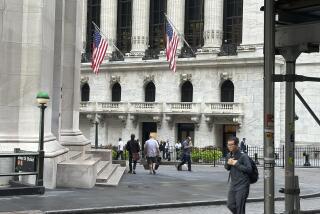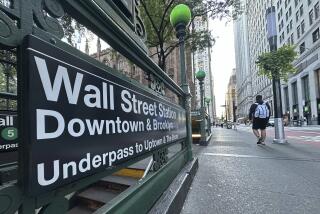Dow Declines 15 in Sixth Straight Losing Session : Market Overview
- Share via
Bank issues and shares of companies vulnerable to the economic cycles led the stock market lower for a sixth straight session amid deepening concern about the strength of the recovery.
* Continued uncertainty about the bond market’s 1993 rally dampened buying sentiment, driving long-term bond yields up to their highest level in two weeks.
Stocks
A series of mildly negative economic reports recently has set a negative tone for the market, and there was another of those on Monday.
The Dow Jones industrial average fell 15.40 points to 3,398.37 on Big Board volume of 283.26 million shares, up from the previous session’s 259.81 million. Declining issues outnumbered advances by about 2 to 1 on the New York Stock Exchange.
The National Assn. of Realtors said sales of previously owned homes fell 2.9% in March, beyond the 1% drop many economists had expected.
“The news is less than good,” said Alfred Goldman, director of technical market analysis with A. G. Edwards & Sons Inc. “The recovery is there, but it is more sluggish than initially thought.”
In addition, the failure of President Clinton’s economic stimulus package has set investors on edge, he said. More stocks once considered the market’s favorite sons were hammered on Monday.
“As we cripple stocks that had made people happy for years, the investment mood deteriorates,” Goldman said.
* Bank shares tumbled. Citicorp fell 1 7/8 to 25 7/8, BankAmerica lost 2 7/8 to 44 1/4, Chemical Bank fell 1 to 36 7/8, and Bank of Boston tumbled 1 1/4 to 21 1/4, all in heavy trading.
Anxiety about banks’ future revenue growth as interest rates rise also helped to depress share prices, said Kevin Timmons, a bank analyst with First Albany Corp.
The negative sentiment over interest rates translated into lower prices for shares of companies sensitive to the ups and downs of the economy. Airlines, electronics, forest products and auto stocks all fell.
* Ford Motor fell 1 1/8 to 51 1/8, Hewlett-Packard dropped 2 3/4 to 70 3/4, Louisiana Pacific tumbled 2 1/8 to 70 3/8, and UAL, the parent of United Airlines, lost 4 7/8 to 139 3/8.
The transportation index plunged 37.47 points, or 2.32%.
* Most gold stocks, however, bucked the downward trend. Placer Dome rose 1/2 to 17 1/8, Battle Mountain Gold rose 1/2 to 17 3/8, and ASA rose 3/8 to 43 1/2. Gold is often considered a hedge against cost-of-living increases, and inflationary fears have crept back into the market.
Gold mining giant Newmont Mining rose 1 to 46 7/8 after the company confirmed that investment funds controlled by British investor George Soros had bought a stake of nearly 10% in the firm.
* The most active NYSE issue was Norsk Hydro, the oil and gas company, which rose 1 1/4 to 25 1/4, with more than 13 million shares trading hands. The company said first-quarter net profit was up 133% from a year ago.
* The NASDAQ average tumbled 12.54 points to 645.87, crumbling nearly 2% under the weight of heavy losses in chip maker Intel Corp. Intel fell 5 3/8 to 87 3/8. The Wall Street Journal reported that Motorola is pursuing an aggressive marketing strategy that may mean low prices for the next generation of personal computers.
Credit
Bond trading was light, with many traders sidelined ahead of several economic releases this week, notably Thursday’s gross domestic product figures. Soaring gold prices, a possible sign of higher inflation, also contributed to the caution.
The Treasury’s main 30-year bond yield rose to 6.83% from late Friday’s 6.79%. It was the long bond’s highest yield since reaching 6.85% on April 8. The bond’s price, which moves in the opposite direction, slumped 15/32 point, or $4.69 per $1,000 in face value.
Bond market worries about inflation have been fed by the sharp rise in gold prices, which surged $6.30 an ounce Monday to a nine-month high and contributed to a jump in the Commodity Research Bureau’s daily index of price changes.
The CRB index rose 1.29 to 210.81 Monday after a 1.42 advance in the previous two sessions.
“Any way you cut it, there seems to be some flight to hard assets. I would guess the movement in commodity prices is putting a negative tint in the picture,” said Dan Seto, an economist at Nikko Securities International Co.
James Fitzgibbons, chief investment strategist at Tokai Bank, said much of the concern over higher inflation is not justified given the recent string of negative economic reports.
On Friday, for example, the Commerce Department said new orders to factories for durable goods plunged an unexpectedly large 3.7% in March despite a rebound in military equipment orders.
The federal funds rate, the interest on overnight loans between banks, rose to 3.125% from late Friday’s 2.813%.
Other Markets
The dollar staged a broad decline against European currencies as fresh signs of U.S. economic weakness helped persuade traders to load up on British pounds and German marks.
On foreign-exchange markets, the dollar advanced only against the yen as world leaders continued to tone down their recent support for a stronger Japanese currency.
In New York, the greenback settled at 110.60 Japanese yen, up from late Friday’s 110.50 yen. The dollar closed at 1.568 German marks, down from 1.583. The British pound fetched $1.5840, more than late Friday’s $1.575.
Meanwhile, in commodities trading, light, sweet crude oil for June delivery fell 4 cents on the New York Mercantile Exchange to $20.30 a barrel.
Market Roundup, D8
More to Read
Inside the business of entertainment
The Wide Shot brings you news, analysis and insights on everything from streaming wars to production — and what it all means for the future.
You may occasionally receive promotional content from the Los Angeles Times.










